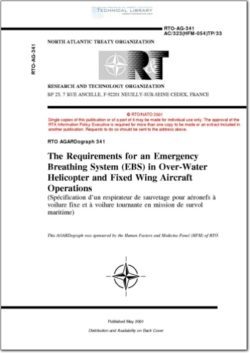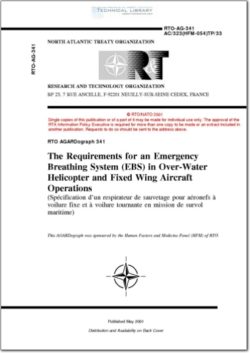AGARD-RTO-AG-341

- Version
- 184 Downloads
- 5.21 MB File Size
- 1 File Count
- April 28, 2016 Create Date
- April 28, 2016 Last Updated
The Requirements for an Emergency Breathing System (EBS) in Over-Water Helicopter and Fixed Wing Aircraft Operations

When a helicopter ditches, it commonly inverts and sinks rapidly. Even if the accident is survivable,
the astonishing fact is that fifteen percent of the crew and occupants will perish. The basic reasons why
occupants have difficulty making underwater escape, have already been extensively discussed in
AGARDograph No 305 by one of the authors titled “The Human Factors Relating to Escape and
Survival from Helicopters Ditching in Water” published in 1989.
Since this was completed, the two authors have conducted further research on the principal causes of
this regrettably high fatality rate. The conclusion to be drawn is that the occupants simply cannot hold
their breath long enough to make an escape, and the cause of death is drowning. The fatality rate does
not appear to be diminishing.
In Chapter I, this AGARDograph describes the extent of the problem, provides the latest helicopter
ditching statistics, the causes of the problem, the factors determining the time required to make an
underwater escape, the factors determining the time available for escape and the rationale for the
provision of an Emergency Breathing System. Chapter 11 describes (a) the development of Emergency
Breathing Systems for underwater escape specifically citing progress in the Royal Navy; (b) progress
in the UK. Civilian North Sea Helicopter Operation with special reference to the introduction of a
novel re-breathing system; (c) progress in the US. with the US. Coast Guard pioneering effort in
introducing the first oxygen re-breather system into helicopter service, and the US. Navy progress
with their first procurement of 8,200 compressed EBS units and reports of the first lives saved with this
unit - HEED H; (d) the Canadian progress demonstrating the fact, which is very common among
military organizations, that it took eight years to introduce a piece of already proven diving equipment,
requiring only the tiniest modification into service; and (e) the introduction of EBS into the Italian,
New Zealand and Singaporean Navies. Chapter 111 reviews the currently available emergency air
supplies for underwater escape from helicopters on the market or potentially coming to market. This is
followed with discussion on the choice of a re—breather or compressed air system in Chapter IV.
Chapter V discusses the importance of producing a course—training package prior to the introduction of
a system into service and describes a typical package example from the US. Coast Guard and a
civilian training school at Survival Systems Ltd. in Canada. Finally, Chapter VI summarises the whole
situation on EBS as we enter the Twenty-First Century.
| File | Action |
|---|---|
| AGARD-RTO-AG-341 The Requirements for an Emergency Breathing System (EBS) in Over-Water Helicopter and Fixed Wing Aircraft Operations.pdf | Download |

Comment On This Post